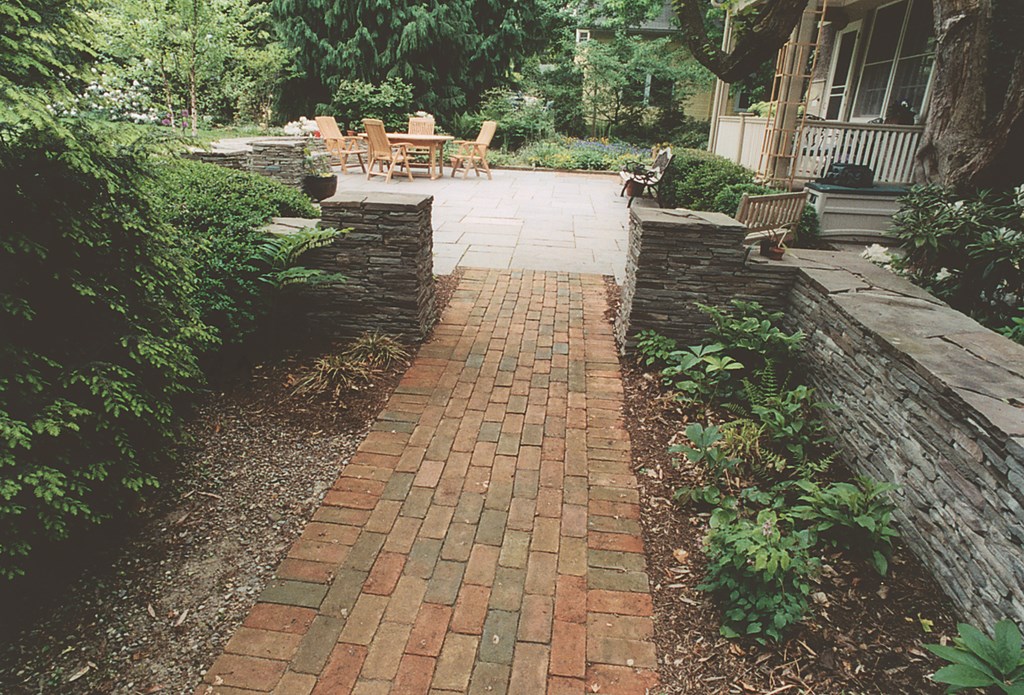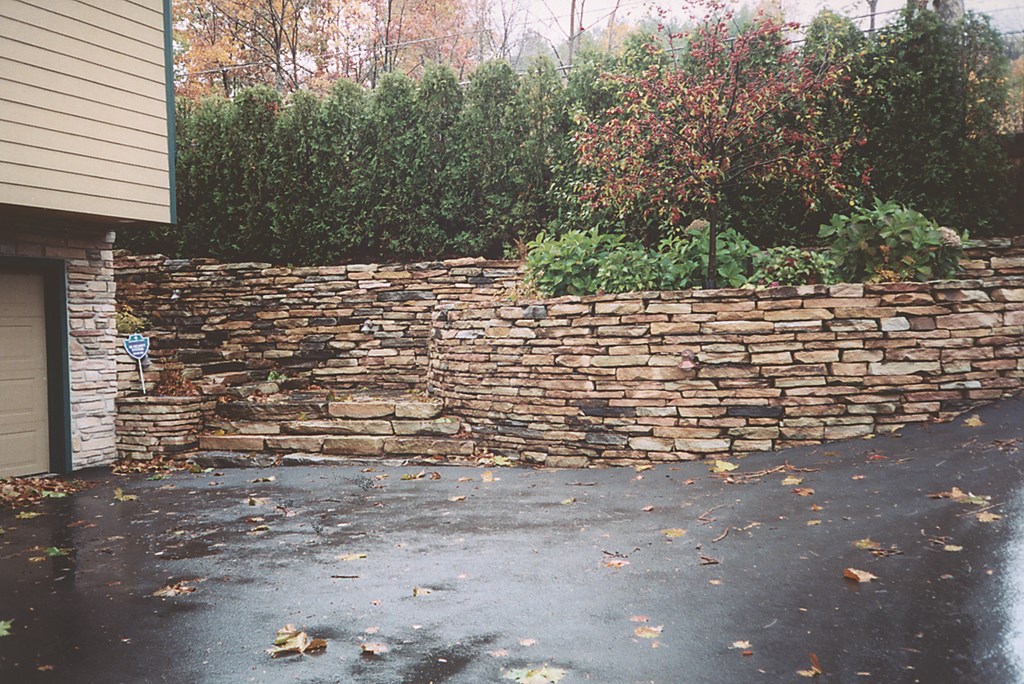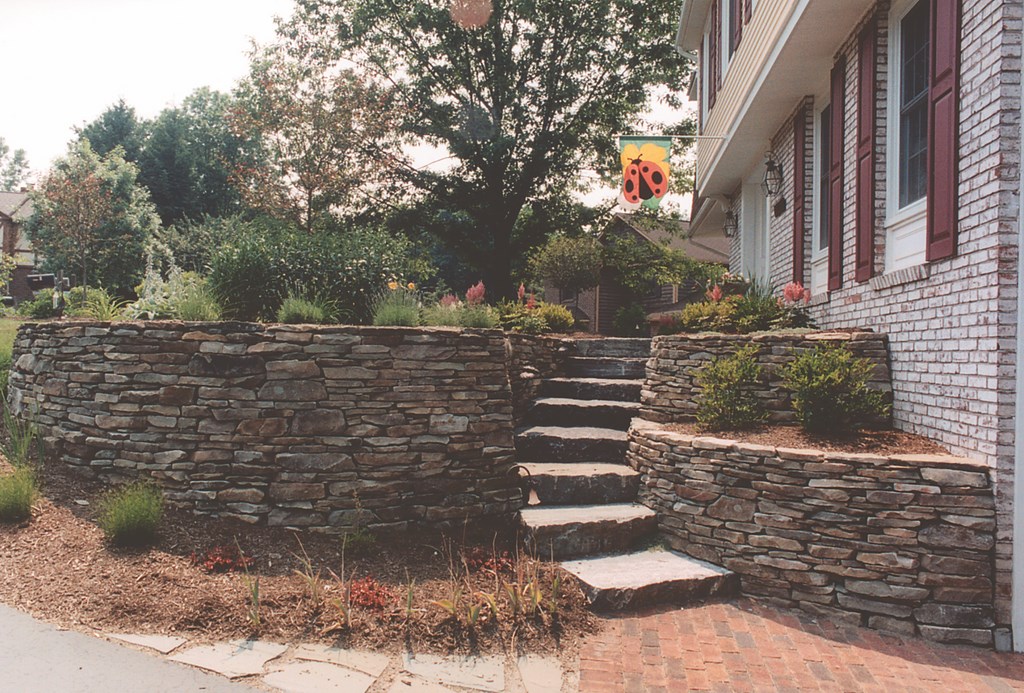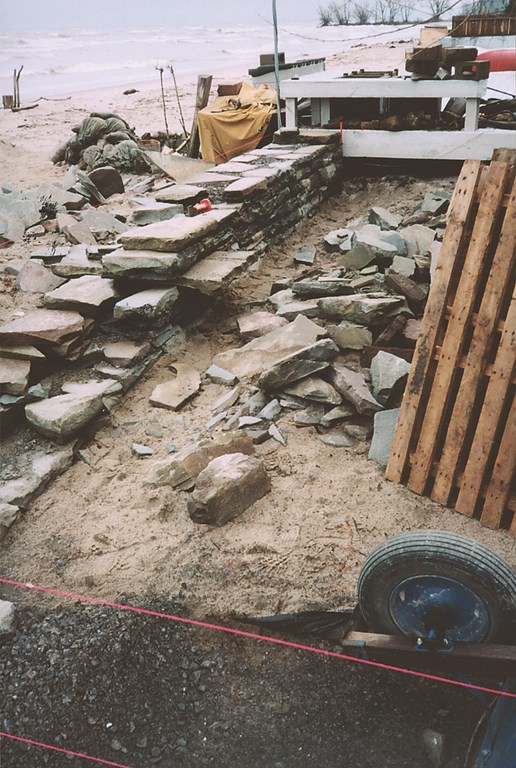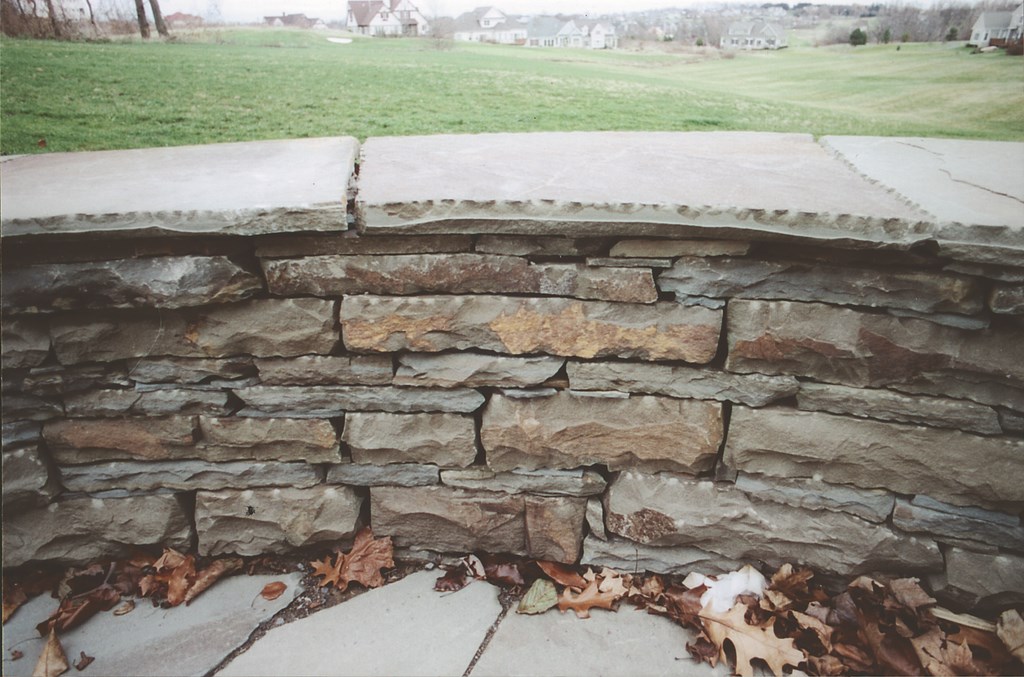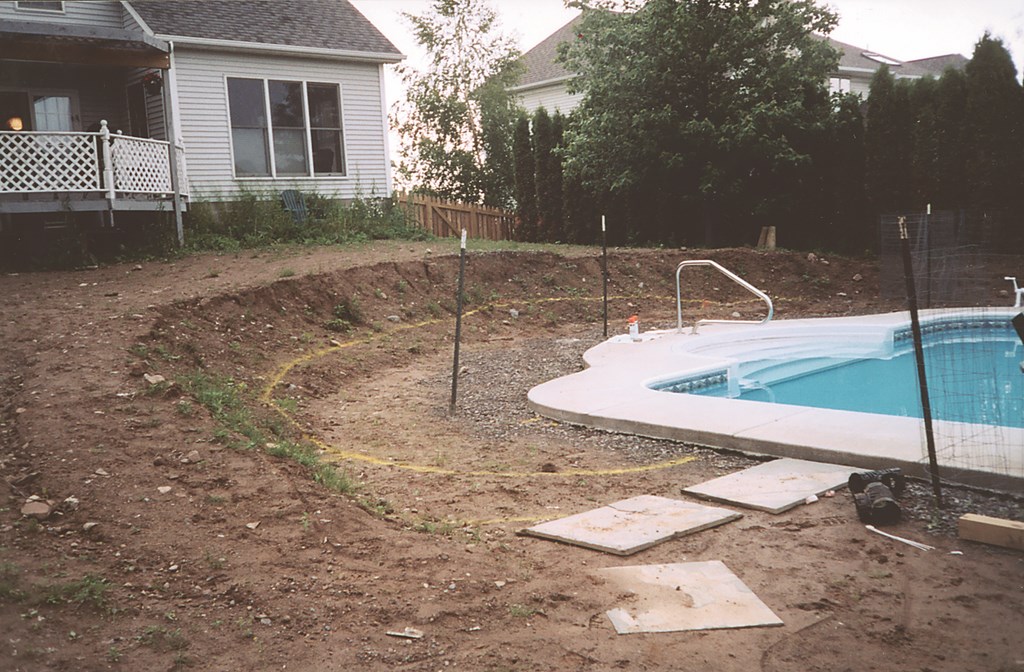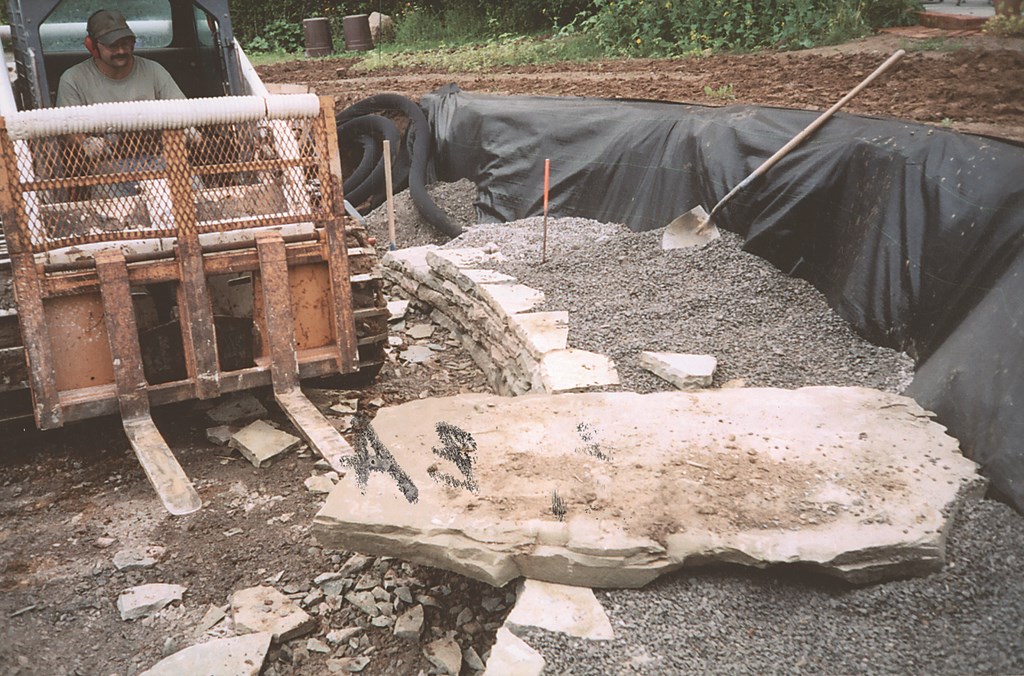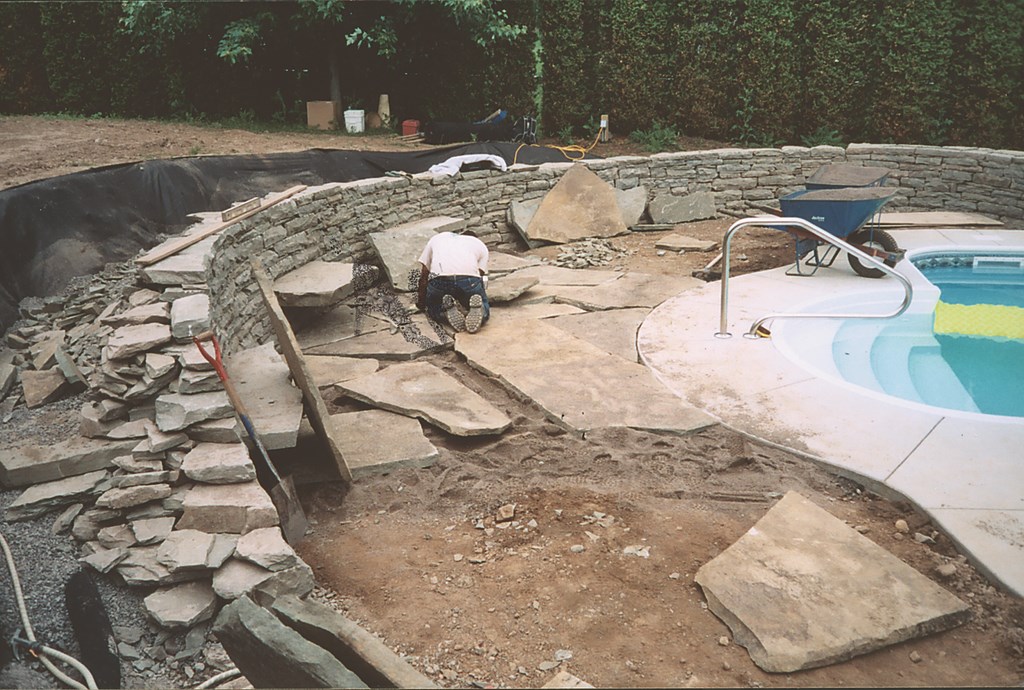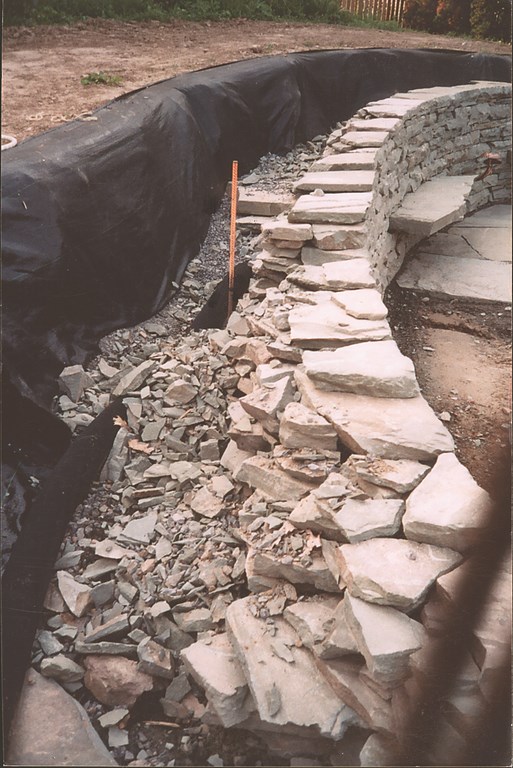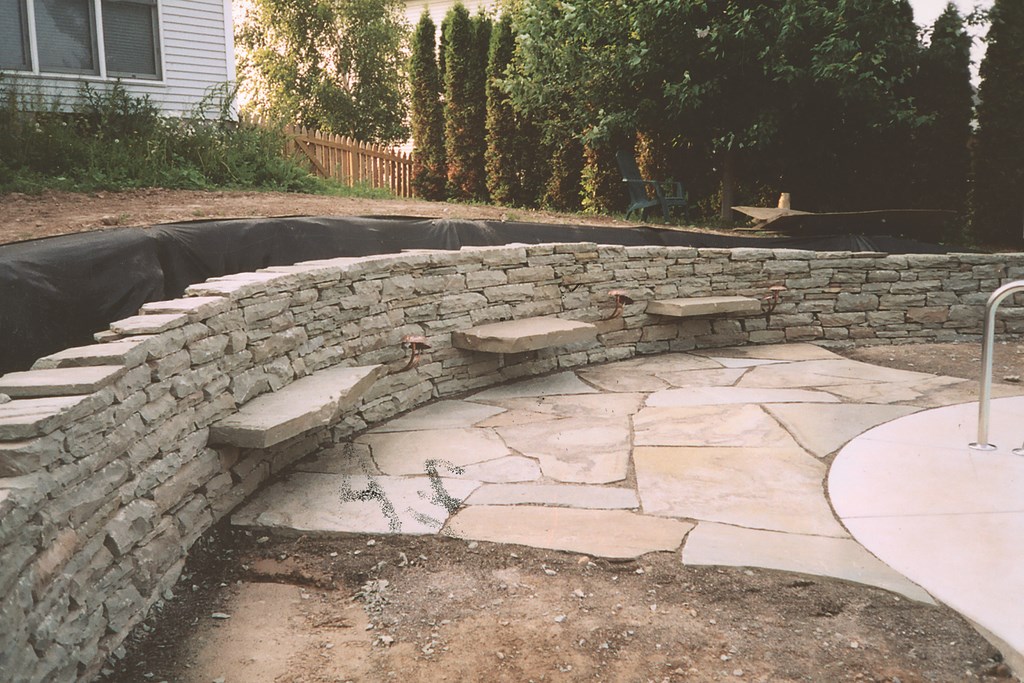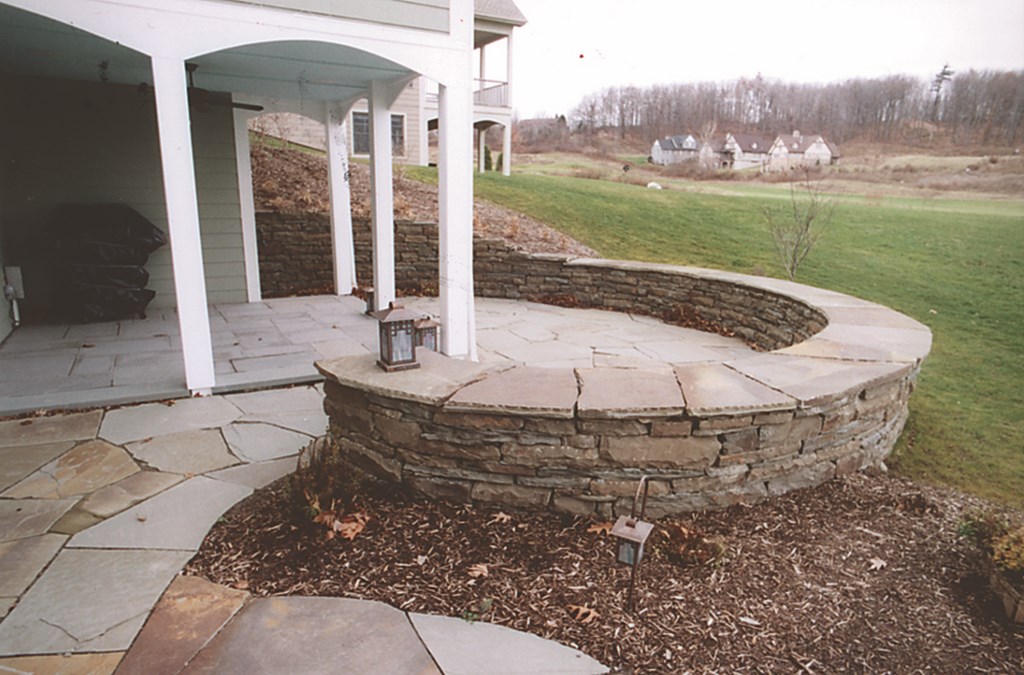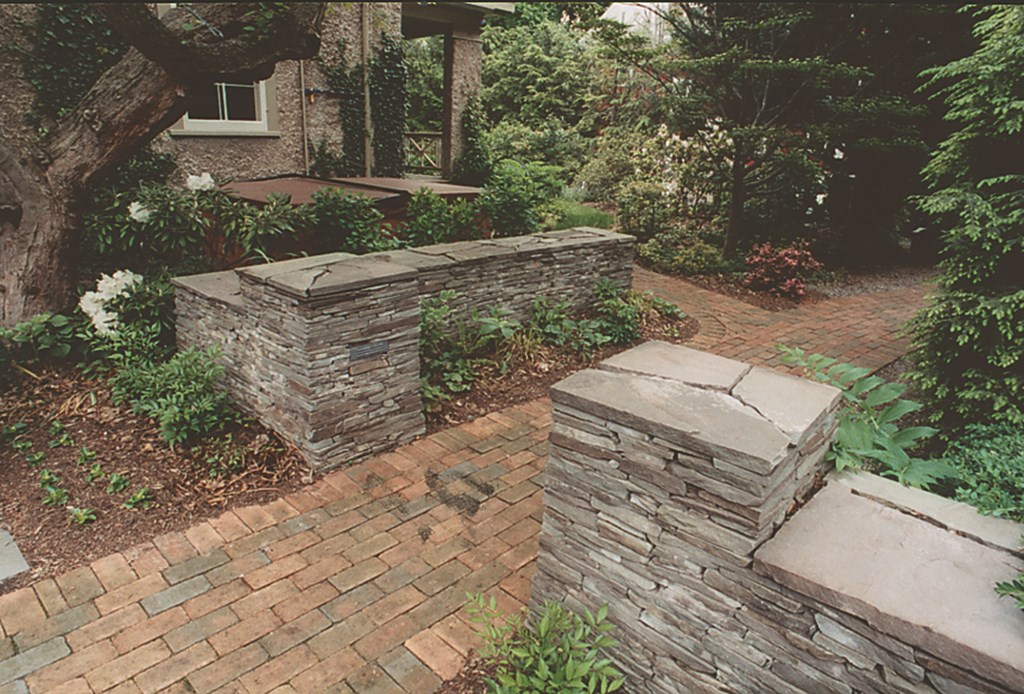Walls of Stone
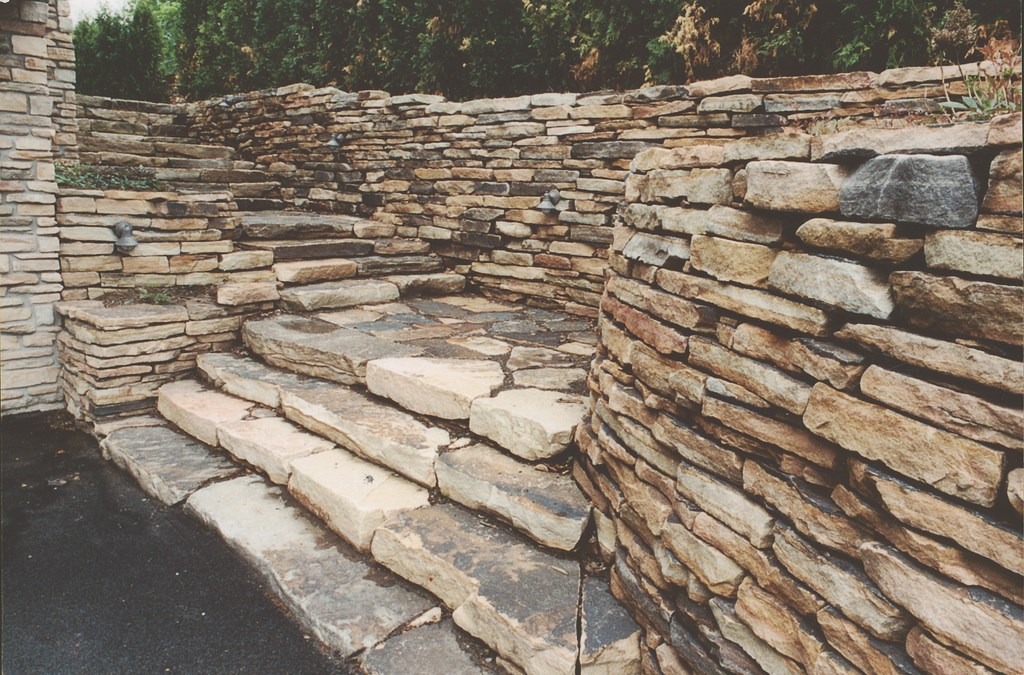
As a landscape designer and installer, I have an abiding fascination with stone.
I love the feel of it and its myriad colors, veins, streaks, shapes and textures, and I particularly admire its strength and flexibility. We pave with it, sculpt it and run water over, under and through it. It doesn’t need painting or much care, looks great with plant material and has, as those who work with stone will point out, a timeless quality that cannot be reproduced with artificial materials.
The best thing about stone is that when you use even one piece in an aesthetically meaningful way, you’ve created art with it: It becomes sculpture just by being.
At Zaretsky and Associates (Macedon, N.Y.), our goal in building any wall is to make it practical, beautiful and functional – practical and functional in its ability to hold up an embankment, separate a garden into “rooms” or create seating; beautiful in that every such wall is unique, a work of art, a piece of sculpture.
One of my favorite applications of stone is in the form of dry-stacked walls. Indeed, these walls are among the most beautiful to be found in any landscape: With plants growing over them, through them or in front of them, a well-designed dry-stacked wall can look hundreds of years old in a matter of months.
As is true with all objects of beauty that are actually used, however, these stone walls require great care, patience and skill in the making. Whether you’re building a fence or retaining wall, the work is hard and labor intensive – and mistakes are costly.
FENCES AND WALLS
An ancient technique that takes a great deal of practice, the art of dry-stacking boils down to selecting and placing stones so that gravity and friction result in a fence or wall that possesses structural integrity.
[ ] Stone fences are freestanding, “faced” on both sides, and can be built to almost any height so long as they are structurally sound enough to stand without the possibility of collapse, which includes resisting movement related to freeze/thaw cycles and incidental vibration caused, for example, by passing vehicles.| SOLID PERFORMANCE: Dry-stacked walls work as either free-standing fences (left) or as retaining walls (middle). In both cases, they can be of just about any height and be either linear or curved. When engineered properly for retention, they can bolster substantial slopes (right, a ‘before’ view of the middle photograph) – without the aid of any mortar. |
In all cases, the work begins with understanding the raw material – and there are countless types of rock available for use in wall construction.
|
To Cut or Not to Cut? The choice of whether to fit a stone as is or cut it with a hammer is just that: a choice. In making that choice, we are sometimes influenced by the look of the home or site factors and will cut stones to give a wall or fence a more sculptured, architectural look – or leave them alone for a more rugged, rustic look. I know stonemasons who cut every stone – and others who won’t even carry a hammer. I fall somewhere in between, invariably finding that something I see on site will guide me in my decision. So let the site talk to you: Ultimately, the stone will find its way. — B.Z. |
In most cases and for two reasons, it’s more practical and cost effective to use stone that is native to the area in which you are working: first, a native stone will more often than not look like it belongs; second, the cost of shipping will be significantly reduced. In our budget-conscious business, the high cost of shipping usually precludes the use of more exotic materials. In the northeast, fortunately, we have the availability of a number of stones, including Pennsylvania Bluestone, limestone and fieldstone in various shapes, sizes and colors, all within a five-hour drive.
Each variety of stone works in a different way. Some need to be worked with a hammer more than others to create surfaces that allow for a good fit. The more “sculpting” you need to do, the more time installation will take and the more waste you’ll generate. Again, with budget in mind, it makes sense to use a stone that will look great but also fit together relatively quickly, so while we use a number of different stone species, for efficiency’s sake we tend to select relatively flat stones to keep the cutting and fitting to a minimum.
In most of the projects in the photographs seen here, we used a flat stone called Colonial Wall Stone. On a good day, two experienced “wallers” can install about two tons of this material – about 25 to 30 square feet of wall face.
The key to that kind of performance? Experience.
BUILT TO LAST
There are a number of ways to build stone walls. The biggest variable driving a choice among various techniques is climate.
Everything shown here was built for a climate in which we expect a frost depth of 42 inches, so in our case, base preparation is the key to prevention of settling and wall movement.
| PROPER PITCH: Although the angle is visually slight, the fact that these retaining walls are pitched back slightly from the vertical in a process known as ‘battering’ lends them a significant extra measure of structural integrity. |
In every case – frost or no frost – it is of the utmost importance to be aware of soil conditions beneath your installation. Much of our work is done on new construction, where cuts and fills are a way of life. You need to know where the soil has been manipulated in this way: Too often, I’ve seen sites where someone has built a wall or patio or deck on top of as much as fifteen feet of fill and then wonders why it has settled.
If the site has been filled with anything more than a foot of soil, the only way to settle the soil for proper wall construction is with water. My general preference is to wait through a winter before we build on any new construction site and let nature take care of the settling. In fact, we’ve found that winter’s freeze/thaw cycles will settle the subsoil very nicely without our intervention.
If there are any remaining doubts about compaction when we come on site, we will set up soaker hoses in our work areas and direct the homeowner to run them for one hour per day for two or three weeks. These basic precautions have never failed us.
|
Art vs. Productivity It’s no secret that a great many clients want two things above all: beauty and affordability. For that reason, I believe it’s critical to build quality structures and overall landscapes while being sensitive to cost. I call it a compromise between art and productivity and see it as a challenge that just about every thoughtful artist and craftsperson will face. Productivity can be increased by using products that work faster on site. It’s like using meshed tile instead of setting tiles one at a time: We try to buy stone that already has a good, flat bottom and a clean face so that all we need to do is dress the front of the stone with a hammer (to make it look hand-cut) and set it. This means less waste and lower material costs. Such stone is usually easy to find where we operate, and choices are broad enough in most places to work this measure of efficiency into the process. — B.Z. |
Once the subsoil is fully compacted, we begin to prepare the base for construction of the wall or fence. In both cases, we dig a base that is twice the width of the wall and vary them in depth from six inches to as much as two feet, depending upon soil conditions.
For well-compacted, gravelly soils, for instance, we only need to dig to the minimum necessary depth because these soils drain well and lock in tightly. By contrast, sandy and clay soils need extra consideration. With sandy soils, we’ll dig a little deeper and line the trench with landscape fabric. With clay, we dig to the maximum necessary depth and make sure the soil is wet when it is being compacted. Clay expands when saturated, so if you build on dry clay, the wall will heave when it gets wet.
In climates unaffected by frost, it’s usually sufficient to build stone walls on reliable excavated ground. We never use pea gravel, because it acts like ball bearings. Instead, we install a base layer of crusher run (a mix of crushed stone and stone dust that locks up solidly when compacted) or plain compacted crushed stone. Crushed stone locks in tight and drains well – two very important and necessary features of a good wall base.
The thickness of this base layer varies with the size of the wall. If in doubt, err on the side of having too much: It will never let you (or your wall) down.
THREE KEYS
In assembling a stone fence or retaining wall, keep in mind three specific techniques: battering, the use of “through-stones” and what is called the “one over two/two over one” principle.
[ ] Battering is the concept of stepping the wall back slightly as you go higher. This is done for several reasons: First, by battering on both sides of a fence, you shift the center of gravity more toward the center of the wall, so, as frost movement and other natural events affect them, the stacked stones will tend to move to the wall’s midline. (The same principle also works in soil retention: A battered retaining wall will be significantly stronger than one with a straight vertical contour.)| STEPPING UP: The use of a ‘through-stone’ (the large piece pushing out past both sides of the fence) lends strength to the overall structure by linking the separate faces of the wall. They have the added benefit of providing a convenient step for crossing over the fence in either direction. |
Second, a battered fence uses less stone than a vertical one. Third, because the top of a battered fence or wall is not as wide as the base, it gives you a natural place to use smaller stones to cap things off. (As anyone who builds these types of walls and fences knows, large flat stone are relatively few and far between.)
When building a battered fence on a straight line, it is worth the time and effort to use batter boards – simple wooden frames built to the size of a cross-section of the stone fence. One is placed on each end of the area where the fence is to be built: Strings attached to the batter boards provide a straight line for use in aligning stones. As you go higher, the strings are raised at the same time, maintaining a consistent angle.
All this said, we batter our stone fences back as little as possible, simply because I do not like the look of an excessively battered fence. The look of a perfectly vertical corner that’s cut out of stone is a thing of beauty: So long as we prepare our bases properly, use a good number of through stones and cap the structure as tightly as possible to keep water out, the fences will stand. (We do, however, always batter our retaining walls!)
|
Measuring Skill The vast majority of stone walls and fences you see today are installed “dry” – that is, no mortar is used. In many cases, their stones are cut to fit with a hammer and are carefully placed. When properly installed, in fact, a dry-stacked wall will outlast a mortared one. Regrettably, very few installers in our “get it done fast” world truly practice the ancient art of stone-wall building. Fortunately, organizations such as The Stone Foundation (Santa Fe, N.M.) and The Dry Stone Conservancy (Lexington, Ky.) are working hard to educate the public and interested dry-stone-wallers in the proper execution of this most noble art form. The Dry Stone Conservancy has a certification process that some of the more experienced wall-builders pursue. These certificates don’t involve studying from a book and taking a test: They’re about going into the field and building walls – lots of them – within a certain time frame. They are judged on the quality of the execution, and very few pass and get certified the first time through. And that’s good, because the standards should be high. It also makes those who fail that much more eager to be better at their craft. — B.Z. |
The more through-stones you use, the stronger the fence. And not only should they run fully from the face of one side to the face of the other: They should also be overlapped with other through stones as frequently as possible to create a good friction bond that strengthens both sides of the fence.
As the fence is built up, there will invariably be rubble left over from cutting or breaking the rock. We use this “waste” as infill within the wall, tightly packing it into gaps between the two fence faces. This is not just thrown in; instead, it is carefully placed so that it will not settle over time. These pieces also serve the useful purpose of shimming face stones into place, leveling them and locking them in.
[ ] The “one over two/two over one” principle is a simple rule about overlapping joints as much as possible. Looking at this the negative way, just remember that long vertical seams are sure points of eventual failure.It also pays to remember that dry-stacked walls rely on two forces: gravity (or mass, hence the use of the largest possible stones) and friction. One stone sitting on top of two will apply gravity and friction to both underlying stones, creating a much stronger interface. Building in this way essentially ties the whole wall into itself as a unit, making for an indestructible feature.
A tip: Always bear in mind how you are using individual stones that should be laid with the longest profile projecting into the wall. Using them the other way and stacking long, thin stones parallel to the face of the wall just won’t work for the long haul. Even though it’s hard to resist the temptation to place a really beautiful stone with a long, clean face on it, think about how that stone is going to affect the integrity of structure before using it in that way.
RETAINING STRENGTH
All of the discussion above focused mainly on stone fences, but each point applies to retaining walls as well. The single biggest difference between the two was mentioned at the outset: A retaining wall has to withstand the pressures of the slope it is retaining and deal with water in either its liquid form (as hydrostatic pressure) or its solid form (as frost heave). Thus, it is absolutely critical that proper drainage techniques be used in building a stone retaining wall.
| OVERLAPPING: Another key to a dry-stacked wall’s structural integrity is avoiding vertical seams. We avoided them in this small wall section as a means of using gravity and friction to their fullest possible extents in ensuring long-term strength. |
One advantage of a dry-stacked stone wall is that it allows water to weep out of its face, but while this certainly helps, it is not sufficient on its own. Our philosophy is simple: The more crushed stone we can place behind a wall, the less moisture will be retained behind it. As a rule, we dig out the area behind the wall to its natural angle of repose – that is, the point at which the soil is self-sustaining.
That is sometimes a difficult angle to determine, so, knowing that the sides of the pyramid will not collapse as long as no other outside influences affect it, we work the soil behind the wall to an angle of 45 degrees. Knowing the height of the wall, we dig into the slope so that the distance from the back of the bottom of the wall is about two feet into the slope (to allow for crushed stone at the base of the wall) and that the distance of the soil from the back of the top of the wall is two feet plus approximately the height of the finished wall.
All of this area should be filled with a large, crushed stone (we use #2) at a minimum. If the wall will have plantings on top, we typically will fill to within about 12 or 18 inches of the top, lay down landscape fabric and then cover the fabric with topsoil. (The fabric keeps the soil from filtering down into the crushed stone.)
| SYSTEMATIC: There’s a logical progression to installing retaining walls, starting with marking the site to guide excavation, base preparation and installation of the behind-the-wall drainage system (top left). As the wall goes up, we backfill with crushed stone to make sure all gaps are filled and install through-stones for increased stability (middle left). In this case, the through-stones double as poolside benches (middle right). Many of the stones are hammered and chipped to ensure tight fits; the spoils are used behind the wall as we go to fill gaps and lock the wall stones in place (right). The gap behind the finished wall is ready to be filled with topsoil for planting (bottom left). |
That last little detail leads me to observe that there are many little details that must be accommodated in building a stone wall of any kind. When building a stone fence, for example, we start by setting aside any stones that are at least two feet longer than the fence is wide. As we go, we set these stones up as an exposed staircase into the fence, allowing people to climb up one side and down the other. This was a fairly common technique in centuries past: It keeps folks from pulling on the wall and its cap stones in attempting to scale the fence and works to the structure’s long-term benefit.
In the same vein, we sometimes use those long stones in retaining walls to create benches. We often place six-foot-long slabs of stone into walls, projecting out from the face about 18 inches. The bench itself is the proverbial tip of the iceberg, with more than four feet of stone buried in the wall and the gravel beyond. One and all can rest assured that such a bench will not move.
THE TEST OF TIME
Stone walls and fences have proved their worth through the centuries. Done properly, they are beautiful, structurally sound and extremely satisfying to build and will endure to the benefit and enjoyment of countless future generations
People travel the world and stand in awe before the pyramids of Egypt, the Great Wall of China, the aqueducts of the Roman Empire and castles and stone fortresses the world over – the works of faceless masons in whose traditions we operate to this very day. What greater compliment could we be paid as designers and builders than to have a future traveler stand and appreciate our work in the same way?
Bruce Zaretsky is president of Zaretsky and Associates, a landscape design/construction/consultation company in Rochester, N.Y. Nationally recognized for creative and inspiring residential landscapes, he also works with healthcare facilities, nursing homes and local municipalities in conceiving and installing healing and meditation gardens. You can reach him at [email protected].











